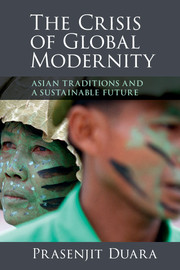Book contents
- Frontmatter
- Epigraph
- Contents
- List of figures and maps
- Preface and Acknowledgements
- Introduction
- 1 Sustainability and the crisis of transcendence
- 2 Circulatory and competitive histories
- 3 The historical logics of global modernity
- 4 Dialogical and radical transcendence
- 5 Dialogical transcendence and secular nationalism in the Sinosphere
- 6 The traffic between secularism and transcendence
- 7 Regions of circulation and networks of sustainability in Asia
- Reprise and Epilogue: of reason and hope
- Bibliography
- Index
- References
4 - Dialogical and radical transcendence
Published online by Cambridge University Press: 05 January 2015
- Frontmatter
- Epigraph
- Contents
- List of figures and maps
- Preface and Acknowledgements
- Introduction
- 1 Sustainability and the crisis of transcendence
- 2 Circulatory and competitive histories
- 3 The historical logics of global modernity
- 4 Dialogical and radical transcendence
- 5 Dialogical transcendence and secular nationalism in the Sinosphere
- 6 The traffic between secularism and transcendence
- 7 Regions of circulation and networks of sustainability in Asia
- Reprise and Epilogue: of reason and hope
- Bibliography
- Index
- References
Summary
But did we kill God when we put man in his place and kept the most important thing, which is the place?
Gilles Deleuze, Pure Immanence: Essays on a Life, p. 71The true philosophical question is, How can concrete fact exhibit entities abstract from itself and yet participated in by its own nature? … Each fact is more than its forms, and each form participates throughout the world of facts. The definiteness of fact is due to its forms; but the individual fact is a creature, and creativity is the ultimate behind all forms, inexplicable by forms, and conditioned by its creatures.
Alfred North Whitehead, Process and Reality, p. 20If both action and agent are non-existent, where could there be the fruit born of action? Where there is no fruit, where can there be an experience? (MKVP 328, 329)
Just as a teacher, through psycho-kinetic power, were to create a figure, and this created figure to create another, that in turn would be a created.
In the same way, an agent is like a created form and his action is like his creation. It is like the created form created by another who is created. (MKVP 330)
Nagarjuna, c. 150–250 CEThis and the following two chapters deal centrally with the theme of religion, spirituality and transcendence in China, India and other parts of Asia from a historical perspective. In terms of the conceptual framework of the book, this part foregrounds the logic of C/culture in the non-Abrahamic traditions in relation to political, and more distantly, economic logics. As such, a principal goal of this chapter is to explore the relationships between circulatory historical ideas and practices and Cultural anchors of transcendence.
- Type
- Chapter
- Information
- The Crisis of Global ModernityAsian Traditions and a Sustainable Future, pp. 119 - 155Publisher: Cambridge University PressPrint publication year: 2014

